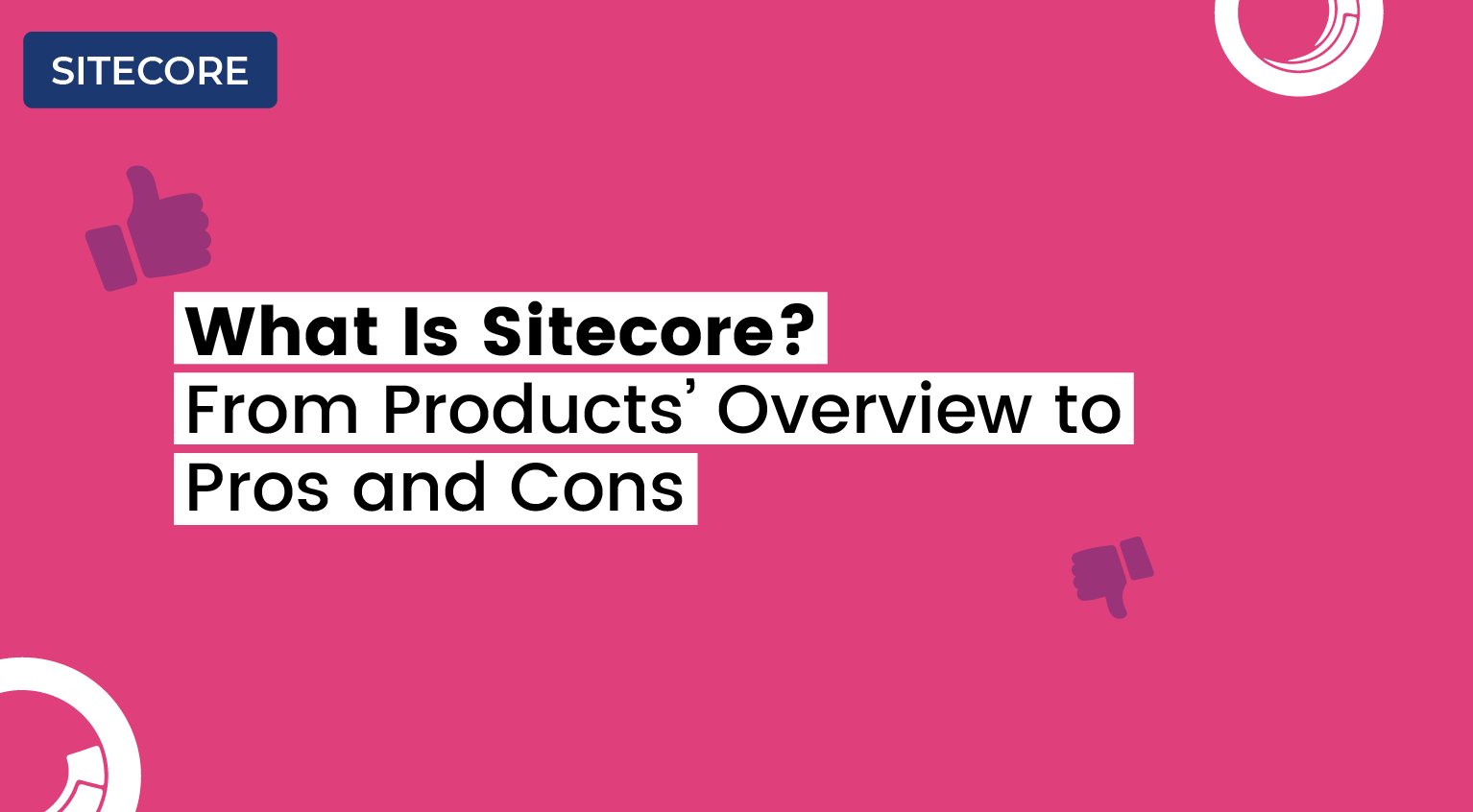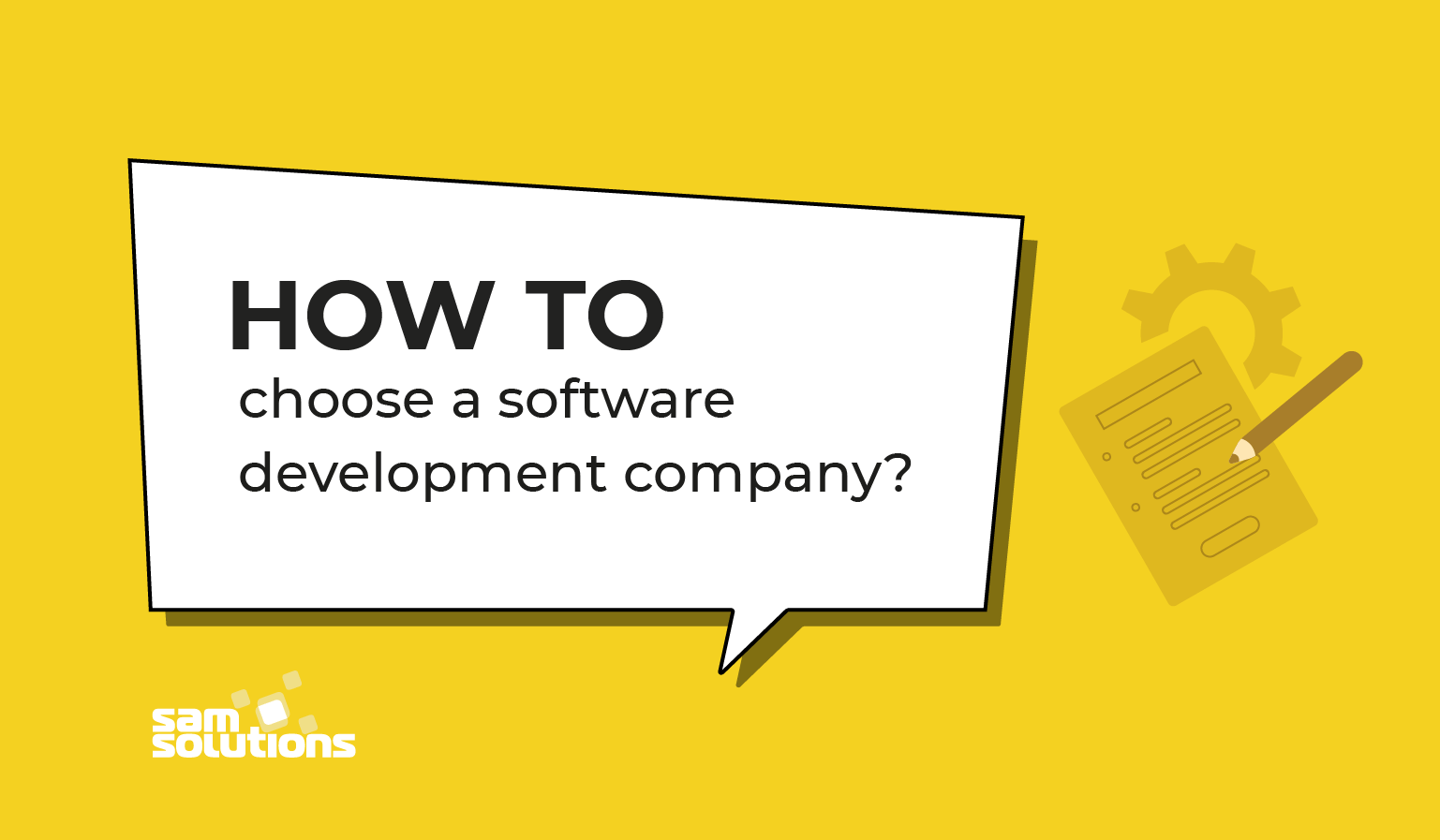Cloud computing is big.
When you consider the impact that the cloud has had on the security, functionality, and scalability of modern business, the above sentiment is an understatement. With nearly 80% of small businesses moving to adopt cloud IT infrastructure fully in 2020, cloud computing has become the primary way for most businesses of all sizes to store data, software applications, and more.
What’s more, our experts—along with the vast majority of industry professionals—believe cloud computing will continue to drive business throughout the 2020s. As a result, cloud migration has become a top priority for enterprises of all sizes.
Before we dive into the details of developing a migration strategy, below is a short FAQ on cloud migrations.
Cloud Migration Strategy
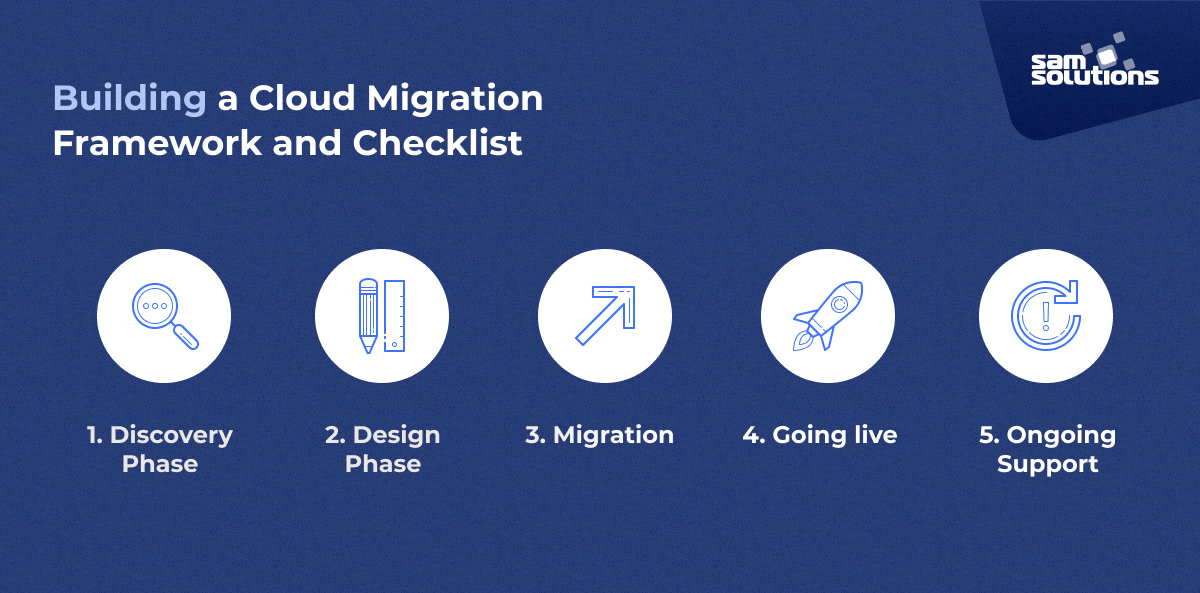
If you’re currently considering migrating your organization’s data and applications to a cloud-based infrastructure, it is crucial to develop a core strategy before beginning the process. Cloud migration is a fairly complicated process, with multiple considerations and moving parts.
62% of businesses report that adopting a cloud infrastructure was more difficult than they had anticipated. Proper research to identify potential issues, thorough planning to address these concerns, and a comprehensive strategy are all essential aspects of a successful migration.
Cloud Migration Checklist
Fortunately, with the assistance of a comprehensive cloud migration framework—and access to an expert cloud solutions provider—you can achieve a smooth transition to your new infrastructure.
Building a framework to structure your migration helps you plan and manage the process and provides you with a checklist to ensure accountability for each step. Also, your framework and checklist can serve as an educational guide and progress report for other stakeholders.
While it’s important to remember that cloud migration is far from a one-size-fits-all process and should be tailored to fit your organization’s unique needs, these are the essential phases and steps of a successful cloud migration:
- Discovery Phase
- Analysis of the existing system landscape and infrastructure
- Formulating KPIs
- Understanding the key pain points of the legacy infrastructure
- Determining success drivers for the future cloud infrastructure
- Design Phase
- Selecting a cloud deployment model
- Choosing a cloud vendor
- Documenting the infrastructure architecture
- Planning the migration project
- Migration
- Infrastructure migration
- Application migration
- Data migration
- Going Live
- Ongoing Support
Step 1—Discovery
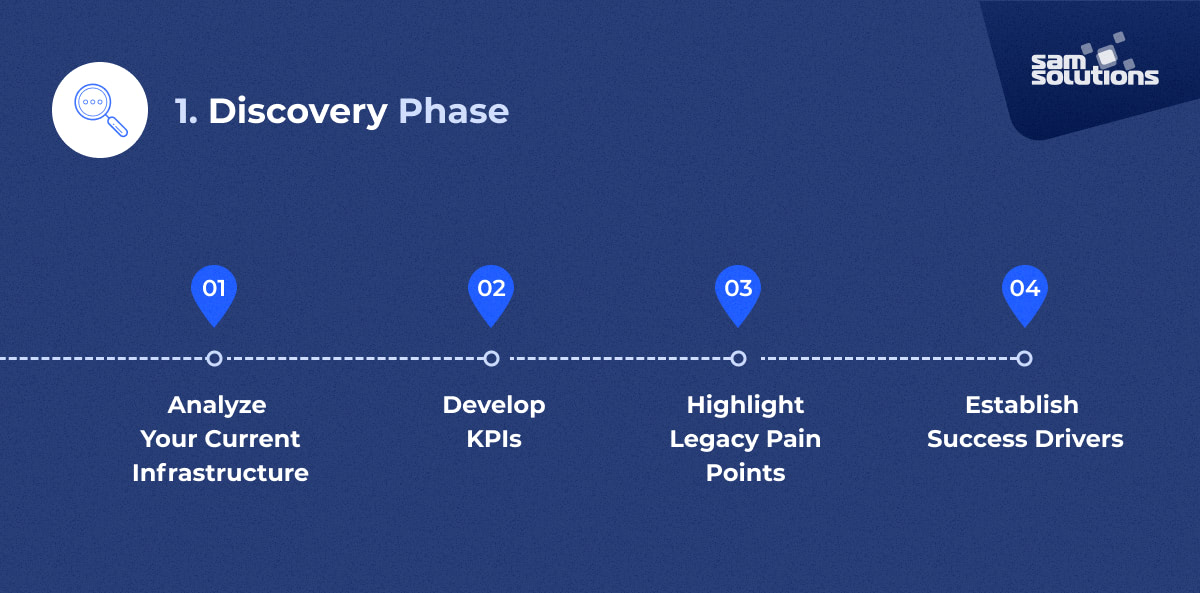
Earlier, we mentioned the importance of designing a cloud migration process that considers your organization’s unique infrastructure demands, and the discovery phase is intended to ensure you do exactly that.
By analyzing your current system infrastructure’s strengths and weaknesses for all stakeholders and determining your needs moving forward, you can ensure your new cloud infrastructure successfully meets your requirements.
Assemble a cloud migration team, including potential cloud service partner experts and your cybersecurity, IT, and finance representatives, and assess your cloud migration priorities from the vantage point of each department on your team.
Analysis of the Existing System Landscape and Infrastructure
Migrating your organization’s workload to the cloud is impossible if you don’t understand the infrastructure you currently have in place. There are a few key questions that should be asked during analysis:
- Which applications and resources are you currently using?
- How could you benefit from cloud migration?
- Which elements could stand to benefit from migration, and which either cannot be ported or would perform better on your legacy infrastructure?
- What is the cost of your current infrastructure used, including physical servers or the management of shared resources?
Consider utilizing an automated tool to discover key characteristics of your current infrastructure, or work closely with your cloud service partner to develop a full picture of all infrastructure, applications, and requirements.
Formulating Key Performance Indicators
Key performance indicators, or KPIs, are metrics you’ve defined that give you a better sense of how your infrastructure is performing regarding your overall purpose.
Identifying the most significant of these can help you assess your current environment, determine changes necessary for your future migration, and help you track the migration’s success while in process and after completion. Depending on the nature of your organization, you may want to focus on any of these common KPIs:
- User experience indicators such as lag or response time
- Application performance indicators including error rates and availability
- Infrastructure KPIs such as memory usage, CPU usage, and network throughput
- Rollout time for new features
Understanding the Key Pain Points of the Legacy Infrastructure
Once you and your migration team have identified your most significant KPIs and established a baseline performance range for each, the areas in which your legacy infrastructure is underperforming should become apparent. Work with your migration team to ensure your key pain points are highlighted for future attention.
Success Drivers for the Future Cloud Infrastructure
Assess your original goals and reasons for wanting to migrate to the cloud. These, combined with your KPI and key pain points, will form the basis for your organization’s unique requirements for cloud success.
Are you prioritizing seamless application and data sharing among siloed departments on your team? Flexible infrastructure or networking capacity? Cost reduction and ROI? Industry-specific data security or other requirements?
Establishing your success drivers now is key to designing a cloud infrastructure that meets them.
Step 2—Design
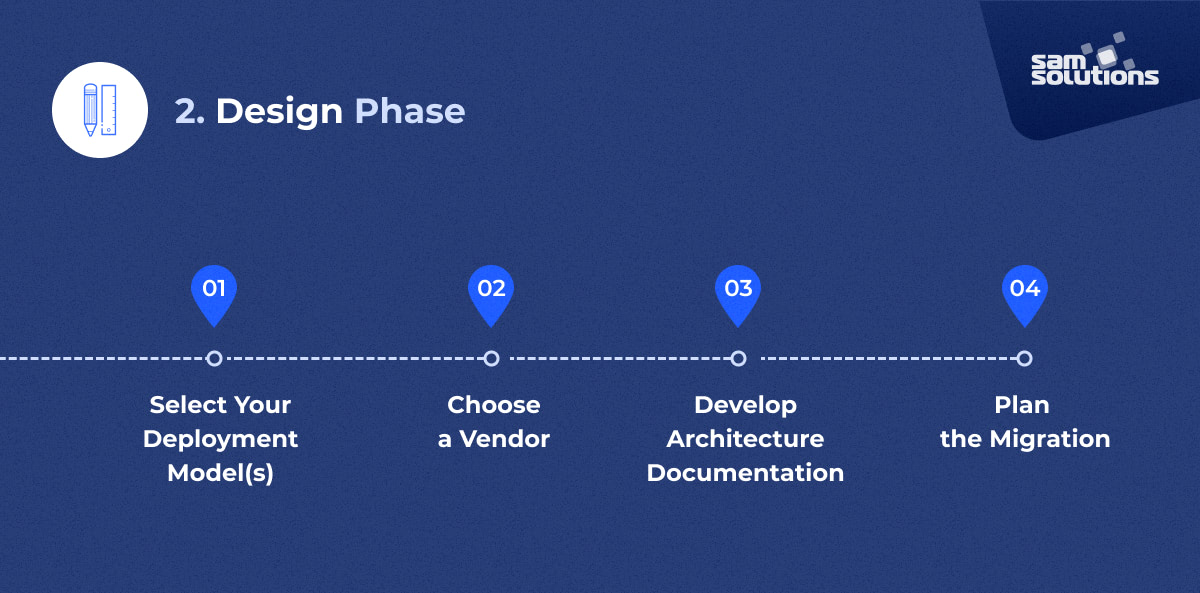
Now that you’ve analyzed your legacy infrastructure’s current specifications, pain points, and your needs for a successful cloud infrastructure moving forward, the time has come to design a custom cloud solution for your organization. Together, your migration team and your cloud services partner will decide the particular deployment model, cloud vendor, and the migration project’s intricacies.
Selecting the Cloud Deployment Model
The cloud deployment model you choose determines who owns and manages your cloud infrastructure and outlines the workload you plan to place upon it. Depending on your organization’s resources; your unique computing, networking, and storage requirements outlined during the discovery phase; and your overall goals, you may benefit from any one of the four most common cloud deployment models:
- Public cloud
- Private cloud
- Community cloud
- Hybrid cloud
Assess the various advantages and disadvantages of each as they pertain to your goals, and choose the cloud deployment model that most closely adheres to your needs.
Choosing a Cloud Vendor
Based on your current infrastructure analysis, your identified success drivers moving forward, and the deployment model you’ve chosen, select a cloud vendor that aligns with your cloud infrastructure needs and goals. In addition, you’ll also want to perform a thorough analysis of potential vendors to ensure the customer service standards, service level agreement, and other components are as expected.
For most organizations, choosing a cloud deployment model and cloud vendor are considerations best handled by a subject matter expert who holds a deep understanding of the cloud. If your organization does not have an internal cloud expert, outsourcing with a cloud services partner who can guide you through these decisions—and the design phase as a whole—puts you at a significant advantage.
Documenting the Infrastructure Architecture
Once the essential decisions are made, it is crucial to document the specific infrastructure architecture—the combination of applications, databases, storage solutions, software capabilities, and other major components—you will put into place. The architecture documentation provides you with a general roadmap for migration and implementation.
Your documentation functions similarly to this migration checklist as a whole—outlining all the major building blocks of your cloud infrastructure and where your applications and data will live, so you can track progress and communicate plans to stakeholders with ease.
While the specifics of your architecture will vary depending on the deployment model, vendor, and other unique considerations, your infrastructure architecture documentation should feature these components at a minimum:
- Cloud resources
- In-house resources
- Software applications, services, and components
- Middleware
Planning the Migration Project
The culmination of the extensive analysis and architecture planning you have undertaken so far, migration planning outlines the specific migration events that will take place.
First, determine if your infrastructure and applications can migrate as-is (also known as rehosting) or if they will require changes for optimization in the cloud environment (refactoring).
Then, work with your migration team and any potential cloud service partners to formulate a migration plan. Ensure you develop a migration plan that:
- Outlines the order of applications for migration
- Allows for baselining of your identified KPIs for success
- Documents necessary changes to any applications and any required training
- Provides deadlines for each step
- Causes minimal downtime or disruption time for your organization or end-users
Step 3—Migration
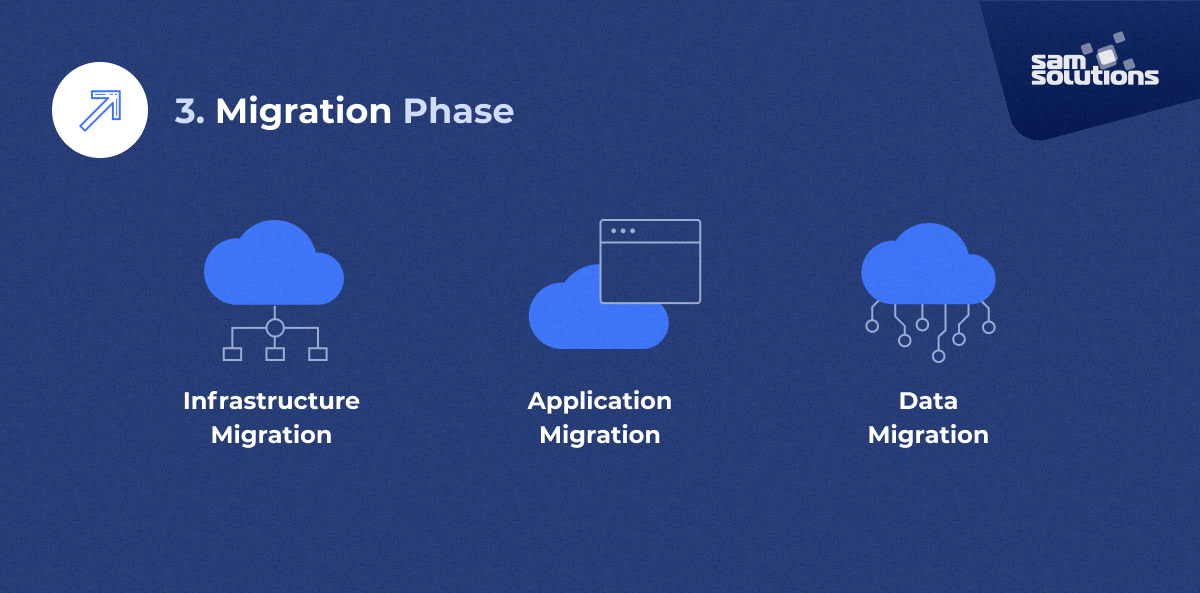
With all the proper analysis and planning in place, it’s time to implement all the decisions you’ve made and migrate to the architecture you’ve designed. However, even with all the necessary preparations, migration is not as easy as simply flipping a switch. The overall migration process can be divided into three significant portions.
Infrastructure Migration
Begin by backing up your existing servers and the data and applications they contain; ensuring your existing environment is easily retrievable and safe from loss is key to preventing catastrophic downtimes if there is a system or process failure. Then, begin establishing the framework of your new cloud infrastructure.
While the overall process depends on your organization’s unique needs, resources, and especially the architecture involved, successful infrastructure migration requires:
- Provisioning, or “setting up” your IT infrastructure and making its resources available to both systems and users
- Configuring the devices, operating systems, and networking necessary to make your infrastructure operable (can be handled manually or via a DevOps team that provides infrastructure as code, or IaaC, services)
- Testing the individual components of your cloud infrastructure, as well as the infrastructure as a whole
- Ensuring connectivity among the cloud infrastructure, the network, and your legacy infrastructure
Application Migration
Once your cloud infrastructure is in place, you’ll need to address the applications you plan to move to the new infrastructure. If you’ve previously determined that your applications are good candidates for rehosting, this process can be as simple as migrating existing applications to the new environment.
However, if any applications require refactoring, the adaptation process will prove a bit more complicated. Additionally, it’s worth noting that it’s sometimes required to update CI/CD processes. Following the order of applications outlined in your migration plan and testing each individually as you go will help you ensure a seamless application migration.
Data Migration
If you’ve effectively backed up and audited your existing data, you should have already identified any potential issues or concerns before migration. After implementing the necessary controls to ensure data quality, begin by extracting data from your legacy system.
Transform your data as needed to fit into your new infrastructure, and load it into place, monitoring any changes necessary to fit the new cloud environment. At each stage of this ETL phase, conduct testing to quickly identify any data loss and misrepresentation for restoration from your backup files.
Step 4—Going Live
After extensive analysis, planning, preparation, and testing, the process to go live should prove relatively uneventful. However, similar to the other steps in the cloud migration process, “going live” does not begin and end with the final announcement that your new cloud environment is live. Preparation is just as important during this stage as any other—be aware of the following considerations for a successful go-live event:
Perform a data freeze. If possible, immediately before your go-live event, halt changes to your legacy environment and perform a final data sync. After this point, document any changes you make in going live and synchronize again after the event.
Ensure minimal downtime. While you’ve built a thorough migration strategy designed to minimize downtime, it can be difficult to fully grasp the actual time going live will take—especially if you have a large data volume or multiple applications.
If possible, perform a trial go-live event so you can get a sense of the time necessary to synchronize your data and troubleshoot any major delays. Once downtime is minimized, consider a reverse proxy technique to route all traffic to your new environment.
Have a rollback plan in place. In the unlikely event that unexpected issues occur or the go-live takes much longer than expected, it is crucial to have a rollback plan in place so you can roll back to your legacy environment. Flexibility during go-live can help you prevent costly downtimes and breaches of service agreements.
Step 5—Ongoing Support
Once you are live, your ongoing success is ultimately determined by the degree to which you provide the proper maintenance and monitoring strategies necessary to sustain a healthy cloud environment. As an enterprise, you will, at minimum, need to review updates and security patches at least monthly and provide application and software updates just as frequently to incorporate the changes.
In addition, consistent performance monitoring, load testing, and application-level testing are crucial to ensure your cloud environment and all the associated tools for business provide the best experience possible for your users.
In most cases, organizations choose to utilize a cloud software development or managed services provider to ensure continuous maintenance and monitoring. In particular, if your business does not have a dedicated migration architect or structured IT staff necessary to handle analytics, testing, and more, you would almost certainly benefit from seeking ongoing, outsourced support.
Read also. AWS vs Azure market share.
Accomplish a Successful Cloud Migration With SaM Solutions
Planning, implementing, and completing a successful cloud migration is a time-consuming and detail-oriented task that is no easy feat. However, choosing to dedicate the proper time and resources necessary is not without reward—if managed correctly, your cloud migration can provide you with the additional security, flexibility, modernization, and cost savings your organization needs for success.
Enhance your cloud migration with cloud-based development and migration services from SaM Solutions. We can guide you through the discovery and design phases necessary to assess your current environment and optimize a new, tailored cloud solution.
Then, we’ll help you choose a platform, deploy your applications, and complete migration to your new environment. Finally, our experts will ensure your cloud environment continues to meet the security and performance goals your business requires for success.
SaM Solutions’ team of cross-technology solutions specialists has over 25 years of experience as a global, enterprise-level partner. We’ve developed comprehensive solutions for numerous multinational corporations around the world, including Siemens, Fujitsu, SAP, Telekom Slovenije, the Instant Group, and many others.
We are proud to be a certified Gold Microsoft Partner and an SAP Silver Partner. Our expertise is centered around Oracle Cloud Platform, Microsoft Azure, Salesforce Heroku, AWS Elastic Beanstalk, IBM Bluemix, and Red Hat OpenShift managed services.
For more information about cloud migration or to begin developing a customized cloud migration plan for your organization, contact SaM Solutions today.
FAQ
How to create a cloud?
- Find a service provider who has a deep-level of cloud computing knowledge and experience.
- Know exactly what your organization wants to achieve from a cloud migration or deployment.
- Determine exactly how necessary a cloud migration is.
- Develop an appropriate cloud migration strategy.
